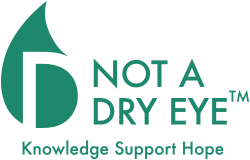Dr. John A. McAree, a board certified physician of Internal Medicine, first became aware of having eye problems at the age of 18 when he tried wearing contact lenses. He never found them comfortable and could tolerate them only for short periods of time. About 10 years later during his residency program, an astute ophthalmologist offered to administer a few tests. Dr. McAree’s Schirmer’s test result was zero in both eyes but his tear break-up time was normal. The diagnosis was Dry Eye Syndrome. He had no additional Dry Eye tests for the next 25+ years, and the only therapy suggested was giving up his contact lenses. Remarkably, his eyes remained fairly asymptomatic during that entire time.

That all changed on August 21, 2017 when Dr. McAree and some friends were boating on a small inland lake in Michigan. It was the day of the solar eclipse. Although he did not look directly at the sun, its rays reflected off the water directly into Dr. McAree’s eyes. By the next morning, his eyes were extremely painful. He assumed that he had developed solar keratitis (similar to “snow blindness”) and would recover quickly. Still in pain a week later, he sought the care of an ophthalmologist who said that except for dryness there was nothing wrong with his eyes, prescribed a one-week course of a non-steroidal anti-inflammatory drop, and suggested using a lubricating drop. Unfortunately, nothing helped.
Seeking Help
Dr. McAree then begged the ophthalmologist for punctal plugs and a RESTASIS prescription. When these treatments didn’t help, the ophthalmologist offered to partially sew his eyes up, at which point Dr. McAree decided to find a different ophthalmologist.

The new ophthalmologist put Dr. McAree on a regimen of steroid drops and resumed RESTASIS. These measures helped a little bit but his eyes remained uncomfortable and his vision blurry. Thankfully, at least the new ophthalmologist was positive and encouraging. Having hope meant a lot.
After several months and no significant improvement in symptoms, Dr. McAree consulted a Dry Eye specialist at a local university who offered little else besides serum tears. One month later there was still no improvement. It was time to takes things into his own hands.
Comprehensive Diagnosis
With some understanding of the pathophysiology of his disease, Dr. McAree diagnosed himself with Meibomian gland dysfunction (MGD). After reading reviews and about available treatments, he decided his best option would be Dr. Steven Maskin in Tampa, Florida who had developed intraductal probing of the Meibomian glands and is very well published.
Dr. Maskin thoroughly evaluated Dr. McAree and diagnosed:
- non-Sjogren’s aqueous tear deficiency
- MGD
- conjunctivochalasis,
- delayed tear clearance
- demodex mites
- possible allergies contributing to the tear deficiency
Dr. McAree first had Meibomian gland probing in August of 2018 which provided subtle but important improvements in symptoms, the most important being increased tear film stability and therefore less visual blurring.
Because of continued foreign body sensations due to conjunctivochalasis, in early 2019 Dr. McAree had amniotic membrane transplant surgery in both eyes. With surgery the comfort in both eyes improved considerably. A second Meibomian Gland probing in June of 2019 improved comfort even more.
Hope Restored
Today Dr. McAree accepts that his eyes are not yet “normal” and will require ongoing treatment. However, he is grateful that an extremely painful and disabling condition is now much more manageable. Work requires time at a computer screen and can cause some discomfort, but he is again able to enjoy hobbies like bird watching and kayaking.

These days Dr. McAree uses RESTASIS daily, scrubs his eyelashes with tea tree oil to control demodex mites, rinses his eyes with saline to eliminate allergens, and still uses lubricating drops, but only occasionally. Plus, he is having injections to combat allergies. He is very hopeful that he will continue to experience improvement in his symptoms, and encourages anyone with debilitating Dry Eye symptoms not to give up hope.
Dr. McAree received his medical degree from Duke University School of Medicine in Durham, North Carolina and has practiced medicine for many years in Grand Haven, Michigan. He joined the Not A Dry Eye Foundation Board to emphasize the importance of accurate diagnosis of Dry Eye, MGD, and related comorbidities, and their treatment with targeted, effective therapies.
Send your questions and comments to blogger@notadryeye.org.
Subscribe to our blog to keep up with Not A Dry Eye. It’s FREE!










